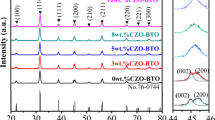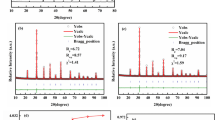Abstract
Polycrystalline samples of Li and Bi co-substituted BaTiO3 were synthesized using microwave assisted heating of the starting materials. This synthesis process extraordinarily reduced the processing time to 40 min, which includes heating and the dwell durations. The room temperature powder X-ray diffraction patterns reveals that the obtained compounds were of pure BaTiO3 phase (BTO). The structural, morphological and dielectric behaviour of these compositions were studied. Improved dielectric properties have been observed with the substitute of Bi and Li. It is interesting to note that the loss tangent of the co-substituted compositions are lower than that of the parent composition and it decreases approximately with increasing extent of co-substitution. This property is quite useful to develop this material further for capacitor applications. The transition temperature has shifted from 120 °C of pure BaTiO3 towards higher temperatures to 150, 160 and 175 °C with (Bi, Li)x where x = (0.02, 0.04 and 0.08), respectively of co-substitution BaTiO3. The change is linear with the degree of co-substitution.







Similar content being viewed by others
References
V.V. Mitic, Z.S. Nikolic, V.B. Pavlovic, V. Paunovic, M. Miljkovic, B. Jordovic, L. Zivkovic, J. Am. Ceram. Soc. 93, 132–137 (2010)
W.S. Jung, J.H. Kim, H.T. Kim, D.H. Yoon, Mater. Lett. 64, 170–172 (2010)
B. Jaffe, W.R. Cook, H. Jaff, Piezoelectric Ceramics. vol. 3 (Academic Press, New York, 1971), pp. 53–56
X. Wang, M. Gu, B. Yang, S. Zhu, W. Cao, Microelectron. Eng. 66, 855–859 (2003)
H. Moriwake, C.A.J. Fisher, A. Kuwabara, Jpn. J. Appl. Phys. 49, 09MC01 (2010)
O. Parkash, D. Kumar, R.K. Dwivedi, K.K. Srivastava, P. Singh, S. Singh, J. Mater. Sci. 42, 5490–5496 (2007)
Z.J. Shen, W.P. Chen, J.Q. Qi, Y. Wang, H.L.W. Chan, Y. Chen, X.P. Jiang, Phys. B 404, 2374–2376 (2009)
P.-H. Xiang, H. Takeda, T. Shiosaki, Jpn. J. Appl. Phys. 46, 6995 (2007)
P.-H. Xiang, H. Takeda, T. Shiosaki, J. Appl. Phys. 103, 064102 (2008)
R. Farhi, M. ElMarssi, A. Simon, J. Ravez, Eur. Phys. J. 18, 605–610 (2000)
Z.-C. Li, H. Zhang, X. Zou, B. Bergman, Mater. Sci. Eng. B 116, 34–39 (2005)
J. Qi, L. Li, Y. Wang, Y. Fan, Z. Gui, Mater. Chem. Phys. 82, 423–427 (2003)
Haifeng, Yinyin Lin, Ting-Ao-Tang, Solid State Communications 135, 304 (2005)
F.D. Morrison, D.C. Sinclair, J.M.S. Skakle, A.R. West, J. Am. Ceram. Soc. 81, 1957–1960 (1998)
J. Qi, Z. Gui, Y. Wang, Q. Li, T. Li, L. Li, J. Mater. Sci. Lett. 21, 405–406 (2002)
M.T. Buscaglia, V. Buscaglia, M. Viviani, P. Nanni, M. Hanuskova, J. Eur. Ceram. Soc. 20, 1997 (2000)
N.K. Karan, J.J. Saavedra-Arias, M. Perez, R. Thomas, R.S. Katiyar, Appl. Phys. Lett. 92, 012903 (2008)
D. Wu, B. Fang, Q. Du, J. Ding, Ferroelectrics 432, 81–91 (2012)
R.A. Eichel, J. Electroceram. 19, 9 (2007)
S.J. Park, H.Y. Park, K.H. Cho, S. Nahm, H.G. Lee, D.H. Kim, B.H. Choi, Mater. Res. Bull. 43, 3580 (2008)
V. Paunovic, L. Zivkovic, L. Vracar, V. Mitic, M. Miljkovic, Serbian J. Electr. Eng. 1(3), 89–98 (2004)
X. Ning, P. Yong Ping, W. Zhuo, J. Am. Ceram. Soc. 95, 999–1003 (2012)
G. Chen, J. Wei, X. Peng, F. Chunlin, W. Cai, Mater. Sci. Forum 787, 236–241 (2014)
S.M. Bobade, D.D. Gulwade, A.R. Kulkarni, P. Gopalan, J. Appl. Phys. 97, 074105 (2005)
A.A. Sattar, S.A. Rahman, Phys Status Solidi A 200, 415–422 (2003)
N. Adhlakha, K.L. Yadav, Smart Mater. Struct. 21, 15021 (2012)
Y. Park, W.J. Lee, H.G. Kim, J. Phys. Condens. Matter 43, 9445–9456 (1997)
V.A. Isupov, Phys. Solid State 45, 1107–1111 (2003)
C. Kajtoch, Mater. Sci. Eng. 64, 25–28 (1999)
G.H. Kwei, A.C. Lawson, S.J.L. Billinge, S.W. Cheong, J. Phys. Chem. 97, 2368–2377 (1993)
Author information
Authors and Affiliations
Corresponding author
Rights and permissions
About this article
Cite this article
Alkathy, M.S., Bokinala, K.K. & James Raju, K.C. Effect of Li and Bi co-substituted on structural and physical properties of BaTiO3 ceramics. J Mater Sci: Mater Electron 27, 3175–3181 (2016). https://doi.org/10.1007/s10854-015-4142-5
Received:
Accepted:
Published:
Issue Date:
DOI: https://doi.org/10.1007/s10854-015-4142-5




